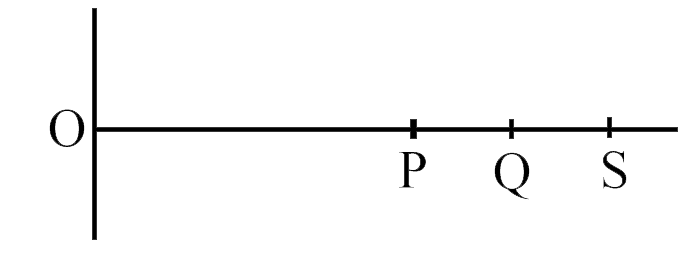A particle is moving with uniform acceleration along a straight line ABC, where AB= BC. The average velocity of the particle from A to B is 10 m/s and from B to C is 15 m/s. The average velocity for the whole journey from A to C in m/s is
12
12.5
13
13.5
The correct Answer is:A
To find the average velocity of the particle moving from point A to point C, we will follow these steps:
Step 1: Understand the Problem
We have a particle moving with uniform acceleration along a straight line from point A to point C, with point B in between. The distances AB and BC are equal. The average velocity from A to B (V_AB) is given as 10 m/s, and from B to C (V_BC) is given as 15 m/s.
Step 2: Define Distances
Let the distance AB = BC = d. Therefore, the total distance from A to C is:
dAC=AB+BC=d+d=2d
Step 3: Calculate Time Taken for Each Segment
Using the formula for average velocity:
Average Velocity=DistanceTime
We can rearrange this to find time:
Time=DistanceAverage Velocity
Time from A to B (T1):
T1=dVAB=d10
Time from B to C (T2):
T2=dVBC=d15
Step 4: Calculate Total Time
The total time (T) taken for the journey from A to C is:
T=T1+T2=d10+d15
To add these fractions, we need a common denominator. The least common multiple of 10 and 15 is 30.
T=3d30+2d30=5d30=d6
Step 5: Calculate Average Velocity from A to C
Now we can find the average velocity (V_AC) for the entire journey from A to C:
VAC=Total DistanceTotal Time=2dT
Substituting T:
VAC=2dd6=2d×6d=12 m/s
Final Answer
The average velocity for the whole journey from A to C is:
12 m/s
---
We have a particle moving with uniform acceleration along a straight line from point A to point C, with point B in between. The distances AB and BC are equal. The average velocity from A to B (V_AB) is given as 10 m/s, and from B to C (V_BC) is given as 15 m/s.
Let the distance AB = BC = d. Therefore, the total distance from A to C is:
dAC=AB+BC=d+d=2d
Using the formula for average velocity:
Average Velocity=DistanceTime
We can rearrange this to find time:
Time=DistanceAverage Velocity
T1=dVAB=d10
T2=dVBC=d15
The total time (T) taken for the journey from A to C is:
T=T1+T2=d10+d15
T=3d30+2d30=5d30=d6
Now we can find the average velocity (V_AC) for the entire journey from A to C:
VAC=Total DistanceTotal Time=2dT
Substituting T:
VAC=2dd6=2d×6d=12 m/s
The average velocity for the whole journey from A to C is:
12 m/s
Similar Questions
A particle is moving with uniform acceleration along a straight line. The average velocity of the particle from P to Q is 8ms–1 and that Q to S is 12ms–1. If QS = PQ, then the average velocity from P to S is

View SolutionA particle is moving with uniform acceleration along a straight line "ABC" .Its velocity at A and B are 6m/s" and "9m/s respectively. If AB:BC=5:16" then its velocity at C is
View Solution
Knowledge Check
A particle is moving with uniform acceleration along a straight line ABC. Its velocity at A and B are 6 m/s and 9 m/s respectively if AB:BC=5:16 then its velocity at C is
A9.6m/s2B12m/sC15m/sD21.5m/sA particle is moving with uniform speed 0.5m/s along a circle of radius 1m then the angular velocity of particle is (in rads−1)
A2B1.5C1D0.5A body is moving with constant acceleration, a=5ms2 from A to B in straight line AB. The velocity of particle at A and B are 5 m/s and 15 m/s respectively. The velocity at mid-point of AB is
A√125msB√250msC√550msD√600ms
A particle moves in a straight line with a uniform acceleration a. Initial velocity of the particle is zero. Find the average velocity of the particle in first 's' distance.
View SolutionA particle, moving with uniform acceleration along a straight line ABC, crosses point A at t = 0 with a velocity 12 m/s. B is 40 m from A and C is 64 m from A. The particle passes B at t = 4 s.
(a) At what time, will the particle be C?
(b) What is its velocity at C?
View SolutionA particle moving with uniform acceleration along a straight line ABC rosses point A at t=0 with a velocity 12ms−1. is 40m away from A andC is 64m away from A. The particle passes B at t=4 s.<br>a.Afterwˆtimewillthepartic≤beatC?<br>b.WˆisitsvelocityatC?<br>c.Wˆdoesthepartic≤reachAaga∈?<br>d.Locatethep∮wherethepartic≤reversesitsdirectionofmotion.<br>e.F∈dthedistancecoveredbythepartic≤∈thefirst15 s.
View SolutionA particle travels A to M along a straight line with a velocity of 8 m/s and M to A with a velocity of 2 m/s,
then the average velocity for the whole journey is –
View SolutionThe velocity –position graph of a particle moving along a straight line is shown. Then acceleration of the particle at s = 15 m is :

View Solution

